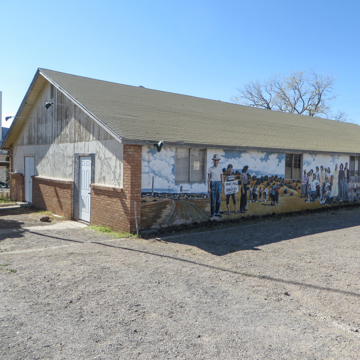You are here
United Steelworkers Local 9424-3 Union Hall
The Mine, Mill and Smelter Workers’ Local 890 Union Hall in Bayard is a repurposed Army barracks whose humble industrial vernacular belies its outsize role in the history of the American labor movement, of the fight for Mexican American rights, and of American films. An organizing center for the strike called in 1950 by miners at the nearby Empire Zinc Mine, the hall then became a site of casting calls and community discussions for the 1954 film about the strike, Salt of the Earth.
Because Grant County possesses significant mineral deposits, mining has been a mainstay of its economy since the late nineteenth century. The Santa Rita Mine, the second oldest copper mine in the United States and one of the largest open-pit copper mines in the world, is located less than two miles from the Empire Zinc Mine. Unions began organizing miners and the workers who processed ore in the early twentieth century; the Western Federation of Miners, the forerunner to the Mine, Mill and Smelter Workers Union, had established a presence by 1914, and Mine-Mill began its regional campaign in 1940, after the passage of key labor legislation in the mid-1930s. Mine-Mill directed its efforts toward recruiting Mexican Americans and addressing the widespread discrimination that riddled New Mexico’s mining industry.
By early 1948, five different union chapters had been amalgamated into Mine-Mill Local 890, which purchased an old barracks from the Army Air Force Base in Deming to serve as its union hall. This simple shed of a building was a place both for union activism and the community, where miners and their families could attend lectures and movies, socialize at dances, bingo games, and parties, and use the reading area; besides the Local 890’s newsletter, the pamphlets, books, and periodicals made available included the People’s Daily World and other leftist publications. Mine-mill would be one of 11 unions thrown out of the Congress of Industrial Organizations for its alleged communist sympathies.
In October 1950, Local 890 went on strike at the mine and mill owned by Empire Zinc in nearby Hanover. The company refused to negotiate and, in June 1951, obtained a court order prohibiting union members from blocking the road to the mine. On the night of June 12, union members and the ladies’ auxiliary gathered at the Bayard union hall and agreed to allow the women to occupy the picket line in place of the men. These women took over the following day and, on June 16, fifty-three of them were arrested and jailed, along with their children. The arrests made national news and were featured in papers like the New York Times.
As the strike and the violence continued, supporters from around the country began to visit the picket line. These included the producer, Paul Jarrico, and his brother-in-law, the screenwriter Michael Wilson, who been blacklisted by Hollywood after they had refused to cooperate with the House Un-American Activities Committee (HU-AC). Jarrico and Wilson decided to make a film that celebrated the women involved in the strike and exposed the discrimination experienced by Mexican Americans in the mining industry. Herbert Biberman, also blacklisted as one of the original Hollywood Ten called before the HU-AC, was the film’s director.
When the strike ended in January 1952, Wilson met with the community in the Bayard union hall to share an outline of the movie, and he adapted his screenplay to reflect the comments and criticisms of the men and women involved in the strike. The hall was also used for casting calls; Juan Chacón, an officer in Mine-Mill 890 and the male lead in Salt of the Earth, read for his part there. The union organizer, Clinton Jencks, later remarked, “Everything in that film comes out of the life of the people.” The Mine, Mill and Smelter Workers’ Local 890 Union Hall has been significantly altered over the years, including the addition of brick face to its terminating sides and replacement of doors and windows. Today, a vibrant mural on the building’s north side depicts scenes of the Empire Mine Strike.
Like its makers, Salt of the Earth was blacklisted—the only film in the history of American cinema to receive this distinction—and was shown in only 13 of the 13,000 U.S. movie theatres when it was released in 1954. Jarrico later said that the filmmakers felt an affinity with the members of the Mine, Mill and Smelters Workers’ Union, because they too had been ostracized for their leftist leanings. In 1992, Salt of the Earth was selected by the Library of Congress as one of 100 films to be preserved in the National Film Registry.
References
Baker, Ellen R. On Strike and on Film: Mexican American Families and Blacklisted Filmmakers in Cold War America. Chapel Hill: University of North Carolina Press, 2007.
Biberman, Herbert. Salt of the Earth: The Story of a Film. Boston: Beacon Press, 1965.
Interviews of Arturo Flores with Dolly Castro, Maury Castro, Lorenzo Flores, Emily Guerra, Josefina Guerra, and Elisa Sanchez., March 15, 2014.
Lorence, James J. Palomino: Clinton Jencks and Mexican-American Unionism in the American Southwest. Urbana: University of Illinois Press, 2013.
Wilson, Michael. Salt of the Earth. With commentary by Deborah Silverton Rosenfelt. Old Westbury, NY: Feminist Press, 1978.
Writing Credits
If SAH Archipedia has been useful to you, please consider supporting it.
SAH Archipedia tells the story of the United States through its buildings, landscapes, and cities. This freely available resource empowers the public with authoritative knowledge that deepens their understanding and appreciation of the built environment. But the Society of Architectural Historians, which created SAH Archipedia with University of Virginia Press, needs your support to maintain the high-caliber research, writing, photography, cartography, editing, design, and programming that make SAH Archipedia a trusted online resource available to all who value the history of place, heritage tourism, and learning.














